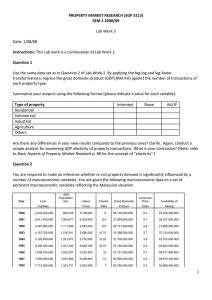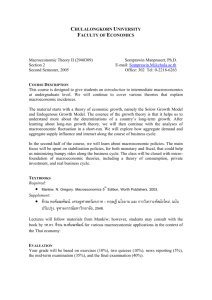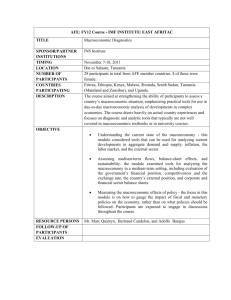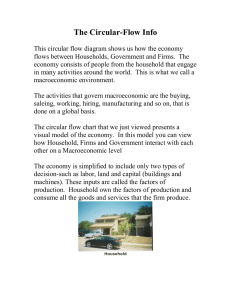Uploaded by
mail
Macroeconomic Modeling Methods: Uzbekistan Economy
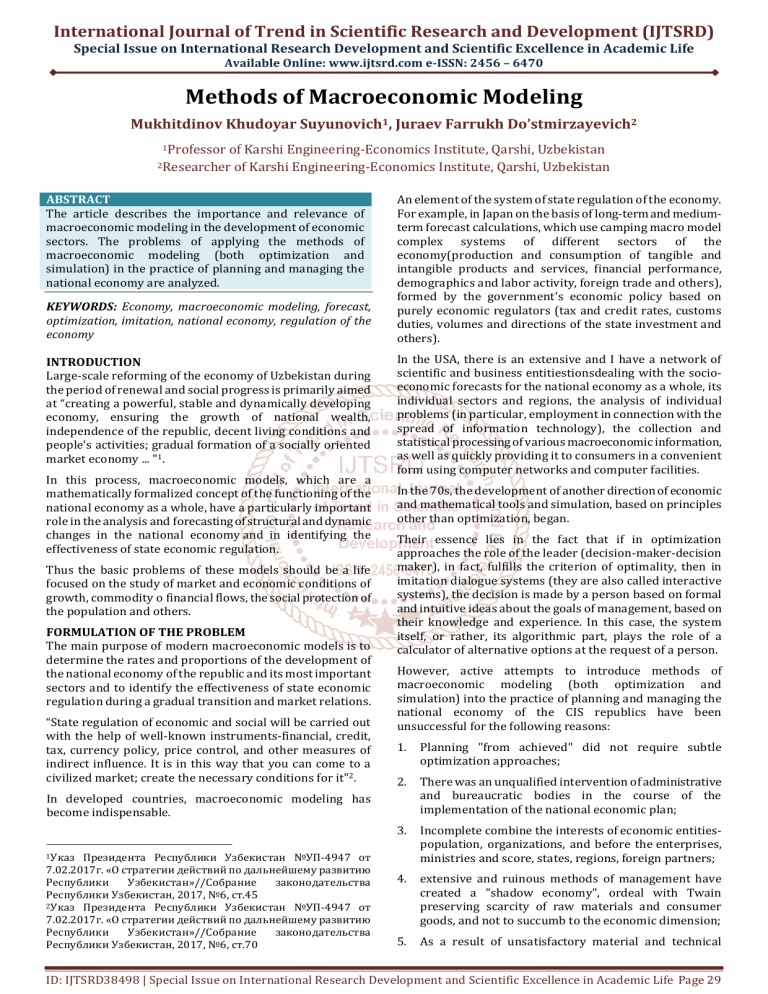
International Journal of Trend in Scientific Research and Development (IJTSRD) Special Issue on International Research Development and Scientific Excellence in Academic Life Available Online: www.ijtsrd.com e-ISSN: 2456 – 6470 Methods of Macroeconomic Modeling Mukhitdinov Khudoyar Suyunovich1, Juraev Farrukh Do’stmirzayevich2 1Professor of Karshi Engineering-Economics Institute, Qarshi, Uzbekistan of Karshi Engineering-Economics Institute, Qarshi, Uzbekistan 2Researcher ABSTRACT The article describes the importance and relevance of macroeconomic modeling in the development of economic sectors. The problems of applying the methods of macroeconomic modeling (both optimization and simulation) in the practice of planning and managing the national economy are analyzed. KEYWORDS: Economy, macroeconomic modeling, forecast, optimization, imitation, national economy, regulation of the economy INTRODUCTION Large-scale reforming of the economy of Uzbekistan during the period of renewal and social progress is primarily aimed at “creating a powerful, stable and dynamically developing economy, ensuring the growth of national wealth, independence of the republic, decent living conditions and people's activities; gradual formation of a socially oriented market economy ... "1. In this process, macroeconomic models, which are a mathematically formalized concept of the functioning of the national economy as a whole, have a particularly important role in the analysis and forecasting of structural and dynamic changes in the national economy and in identifying the effectiveness of state economic regulation. Thus the basic problems of these models should be a life focused on the study of market and economic conditions of growth, commodity o financial flows, the social protection of the population and others. FORMULATION OF THE PROBLEM The main purpose of modern macroeconomic models is to determine the rates and proportions of the development of the national economy of the republic and its most important sectors and to identify the effectiveness of state economic regulation during a gradual transition and market relations. “State regulation of economic and social will be carried out with the help of well-known instruments-financial, credit, tax, currency policy, price control, and other measures of indirect influence. It is in this way that you can come to a civilized market; create the necessary conditions for it"2. An element of the system of state regulation of the economy. For example, in Japan on the basis of long-term and mediumterm forecast calculations, which use camping macro model complex systems of different sectors of the economy(production and consumption of tangible and intangible products and services, financial performance, demographics and labor activity, foreign trade and others), formed by the government's economic policy based on purely economic regulators (tax and credit rates, customs duties, volumes and directions of the state investment and others). In the USA, there is an extensive and I have a network of scientific and business entitiestionsdealing with the socioeconomic forecasts for the national economy as a whole, its individual sectors and regions, the analysis of individual problems (in particular, employment in connection with the spread of information technology), the collection and statistical processing of various macroeconomic information, as well as quickly providing it to consumers in a convenient form using computer networks and computer facilities. In the 70s, the development of another direction of economic and mathematical tools and simulation, based on principles other than optimization, began. Their essence lies in the fact that if in optimization approaches the role of the leader (decision-maker-decision maker), in fact, fulfills the criterion of optimality, then in imitation dialogue systems (they are also called interactive systems), the decision is made by a person based on formal and intuitive ideas about the goals of management, based on their knowledge and experience. In this case, the system itself, or rather, its algorithmic part, plays the role of a calculator of alternative options at the request of a person. However, active attempts to introduce methods of macroeconomic modeling (both optimization and simulation) into the practice of planning and managing the national economy of the CIS republics have been unsuccessful for the following reasons: 1. Planning "from achieved" did not require subtle optimization approaches; 2. There was an unqualified intervention of administrative and bureaucratic bodies in the course of the implementation of the national economic plan; 3. Incomplete combine the interests of economic entitiespopulation, organizations, and before the enterprises, ministries and score, states, regions, foreign partners; 4. extensive and ruinous methods of management have created a "shadow economy", ordeal with Twain preserving scarcity of raw materials and consumer goods, and not to succumb to the economic dimension; 5. As a result of unsatisfactory material and technical In developed countries, macroeconomic modeling has become indispensable. 1Указ Президента Республики Узбекистан №УП-4947 от 7.02.2017г. «О стратегии действий по дальнейшему развитию Республики Узбекистан»//Собрание законодательства Республики Узбекистан, 2017, №6, ст.45 2Указ Президента Республики Узбекистан №УП-4947 от 7.02.2017г. «О стратегии действий по дальнейшему развитию Республики Узбекистан»//Собрание законодательства Республики Узбекистан, 2017, №6, ст.70 ID: IJTSRD38498 | Special Issue on International Research Development and Scientific Excellence in Academic Life Page 29 International Journal of Trend in Scientific Research and Development (IJTSRD) @ www.ijtsrd.com eISSN: 2456-6470 equipment, undeveloped statistical base, low level of payment for intellectual labor, and other reasons, the theory, methodology and practice of such modeling have significantly lagged behind world achievements. ANALYSIS AND RESULTS The retrospective analysis of predictive macroeconomic studies indicates that in recent years more attention has been paid to the development of specific methods of macroeconomic modeling, as a result of which the relationship between the theory and practice of applying the methods of system analysis, complex modeling of the desired (or expected) trajectories of development of the regional economy, taking into account market behavior and harmonization of subjective economic interests. So, for example, in work3the idea of creating an imitation system of macro models to substantiate the consolidated economic indicators of the development of Uzbekistan is embodied in the work. The basis of the proposed system is made up of private econometric macro models, which are practically used for the analysis and forecasting of summary indicators of the regulated market economy of the region (gross national product, consumer price indices, parameters of economic interrelation, summary financial and other indicators), based on optimization of the industry (sectoral) the structure of production capital investments according to the criterion of the maximum national income and expert assessment of the quality of options for macroeconomic decisions. In our opinion, the prospect of these studies consists in the creation of a flexible and universal cybernetic subsystem of complex macroeconomic modeling within the framework of the integrated republican information processing system and the national accounting system. The proposed complex of macro models for forecasting the socio-economic indicators of the republic in the sections of the most important sectors (industry, agro-industrial complex, construction, transport and about them) and regions is based on the complex application of the following methods: inertial-genetic methods of macroeconomic research (passive forecast); normative-target methods of macroeconomic research (active forecast); mathematics and statistical methods of forecasting resources and factors of national production; methods for assessing, agreeing macroeconomic forecast decisions. and making Inertial genetic methods, taking into account retrospective trends and patterns, are used to identify the expected trajectories of regional or sectoral macroeconomic development. Prospective development characteristics are assessed on the basis of the most adequately constructed extrapolation and adaptive econometric models of passive forecasting. The main function of passive macroeconomic forecasting is the preparation of analytical and signal information on the rates and proportions of economic development in order to compare with the desired options for long-term development, as well as identify and substantiate especially important, programmatic national economic problems (fig.1). The figure shows a schematic diagram of the development of macroeconomic forecasts based on a multi-stage iterative approach, the essence of which is as follows. At the initial stage, an autonomous forecasting of aggregate macroeconomic indicators is carried out using macroeconomic models and general trends in the rate and proportion of national production are determined. Based on this approach, those upper and lower boundaries of reproduction processes are identified, within the framework of which private, local, sectoral, regional and other types of forecasts should be determined, i.e. these latter should be based on the preliminary parameters of the aggregate macroeconomic forecasts. On the other hand, private local, sectorial, regional and other types of forecasts make it possible, by summing their indicators, to obtain consolidated macroeconomic forecasts. They make it possible, by summing up their indicators, to obtain a consolidated macroeconomic forecast as a whole at the republican level. On the basis of integrated forecasts, the initially compiled orienting consolidated macroeconomic forecasts are corrected. Thus, the consolidated macroeconomic forecast acts as both the initial (initial, orienting) means of autonomously carrying out various forecast calculations, and the final, final tool for the formation of a comprehensive national economic forecast. 3Чепель С.В. Интеллектуальные компьютерные системы и макромодели функционирования экономики Узбекистана в условиях перехода к рынку.-Ташкент: Фан, 1992.-136с. ID: IJTSRD38498 | Special Issue on International Research Development and Scientific Excellence in Academic Life Page 30 International Journal of Trend in Scientific Research and Development (IJTSRD) @ www.ijtsrd.com eISSN: 2456-6470 Second approach First approach macroeconomic model objectives ………………………….. Regional models Autonomous forecasting of aggregate macroeconomic indicators Industry models Local models Private models General trends in the rate and proportions of national production Upper and lower boundaries of reproduction processes Private, local, sectoral, regional and others, forecasts of socio-economic indicators Integrated forecasts of social and economic development of the Republic Assessment, approval, adjustment and issuance of solutions to macroeconomic problems Comprehensive national economic forecast Fig.1. Comprehensive national economic forecast scheme When determining the "desired" options for long-term development, it is advisable to use normative-target research methods based on pre-formulated goals and scientifically grounded rates of production costs, consumption, accumulation, foreign economic activity, etc. Active forecasts carried out using models of natural value and dynamic inter-sectorial balances, one and many product optimization models, are designed to determine various options for macroeconomic development with the aim of directing the socio-economic system along the "desired" trajectories. They use various (hypotheses of changes in the main regulatory (control) parameters, established depending on the availability of resources, market conditions, standards and targets. Forecasting methods for assessing resources and factors of production are based on the use of private economic and mathematical models: reproduction of the population and labor resources; demand and consumption of the population; economic growth (equilibrium); forecasting financial resources; scientific and technical progress (STP) and ecological condition of the region and others. Methods of purposeful enumeration of development options by varying the values of macroeconomic regulators (such as tax and ID: IJTSRD38498 | Special Issue on International Research Development and Scientific Excellence in Academic Life Page 31 International Journal of Trend in Scientific Research and Development (IJTSRD) @ www.ijtsrd.com eISSN: 2456-6470 interest rates, directions and amounts of financial benefits, government investment, financing of social programs and other.) are used as a reliable tool for obtaining coordinated macroeconomic decisions. are the basis of simulation. A series of variant calculations is performed within the framework of a human-machine simulation system, which includes a simulation model and a human-expert - decision maker, who manages the entire process of assessing and choosing the best option. This choice is made by comparing the options for macroeconomic development in dynamics based on comparing the meaning of various formal criteria and informal assessments. In this case, the decision maker has the ability to change not only the sets of values of the control parameters (regulators), but also to vary the estimates of the significance of various goals. It is on this principle that the simulation model developed by the author for assessing the effectiveness of social production is built5. CONCLUSION In general, the development of macroeconomic models is broken down into the following six interrelated stages: 1. Socio-economic analysis - identification of cause-andeffect relationships, theoretical principles and stable patterns of development of the national economy; 2. Construction of a formalized model in the form of a system of identities, equations and inequalities, i.e. economic and mathematical formalization of the model in order to assess the value of control parameters and endogenous variables based on exogenously set indicators; 3. Selection of strategic (key) variables of the model and determination of alternative options for macroeconomic management decisions; 4. Development of an algorithm and application programs for automating the solution of macroeconomic models; 5. Checking the adequacy of the model on empirical material; 6. Conducting macroeconomic forecasting calculations using a real example, assessing and analyzing the feasibility of the solutions found. развитие экономики «Иқтисодиёт», 2011.-136 с. Узбекистана. Т.: [3] Labanio G. and Moro S. (2013). “Manufacturing industry and economic growth in Latin America: a Kaldorian approach”. 6. Nicola Cantore, Michele Clara, Camelia Soare (2014). Manufacturing as an engine of growth: Which is the best fuel? WORKING PAPER 01/2014. Vienna. [4] J. S. L. McCombie and M. R. M. Spreafico (2015). Kaldor’s ‘technical progress function’ and Verdoorn’s law revisited. Cambridge Journal of Economics. [5] Clarke A. E., Friese C. Situational Analysis in Practice: Mapping Research with Grounded Theory – L.: Routledge, 2015.-347 p. [6] Cornwell B. Social Sequence Analysis: Methods and Applications– Cambridge: Cambridge University Press, 2015.-337 p. The practical significance of the conducted macroeconomic model developments is determined by their flexibility, multi functionality, orientation towards the existing static nature, reliability and explain ability of the results obtained, which serves as the basis for their recommendations as a toolkit for monitoring the economic situation, i.e. tracking the state of the market system based on intellectualized information technology. REFERENCES [1] Указ Президента Республики Узбекистан № УП4947 от 7.02.2017 г. «О стратегии действий по дальнейшему развитию Республики Узбекистан»//Собрание законодательства Республики Узбекистан, 2017, № 6, ст.70. [2] Кадыров А. М., Севликянц С. Г., Отто О. Э., Ахмедиева А. Т. Информационно-инновационное 5Улашев И.О. Алгоритм и программа имитационного анализа основных показателей экономики союзной республики//Алгоритмы.–Ташкент: РИСО АН РУз, вып.67.стр.45 ID: IJTSRD38498 | Special Issue on International Research Development and Scientific Excellence in Academic Life Page 32
